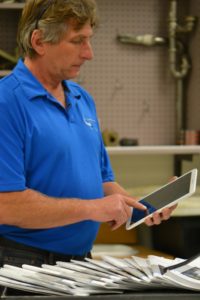Camosun students have saved over $115,000 since 2012 through the Open Textbook Project, according to the provincial government. The project offers free online textbooks so students don’t have to pay for physical books.
The project is spearheaded at Camosun by Plumbing and Pipe Trades instructor Rod Lidstone, who says that Camosun was given “copyright freedom to modify” Trades Access Common Core textbooks by the Industry Training Authority.
“In the entry-level section, the previous textbooks that they replaced probably cost about $250, so that’s the savings per student,” says Lidstone, speaking on the savings for Plumbing and Pipe Trades students specifically. “We’re doing a lot of partnerships with high-school programs: dual-credit programs, where they’re registered in the college and they’re taking their high-school shop programs. If they were to continue on, they could get recognition for the work that they’ve done in high school. High-school students’ budgets are always very tight; these are perfect for the high-school programs as well.”
As to the publishers who are no longer receiving thousands of dollars a year from Camosun students, Lidstone says they are not his first priority.

“It’s not necessarily my biggest concern,” says Lidstone. “I have a bigger concern for the students. That’s number one. Whatever shakes down after that is not really in my focus.”
(Representatives from two textbook-publishing companies did not respond to requests to be interviewed for this story by deadline.)
Minister of advanced education Andrew Wilkinson says that the Open Textbook Project has “no downside” for students.
“The academic publishers were basically playing games with students by rearranging chapters in books that had been around for decades,” says Wilkinson.
Wilkinson says that the project has started to lift off in recent months, with more and more students opting for free, paperless textbooks. He says that the government made a specific effort to focus on trades programs because of the “ridiculous” high cost of textbooks despite the fact that they are often “very small.” Wilkinson says that the government is currently “pushing 170 textbooks” in the program.
“So far we’ve saved students [across the province] about $2 million,” says Wilkinson.
Camosun College Student Society (CCSS) external executive Rachael Grant says that the Open Textbook Project will help students with learning disabilities and make education more accessible; she says she would like it to grow in the future.
“Textbooks are a huge barrier for students to be able to properly access post-secondary, especially with the rise in the cost of textbooks,” says Grant. “It’s something that students definitely struggle with. It’s really great to see the BC government supporting this particular initiative.”
Wilkinson draws attention to one example at the University of British Columbia. He says that instead of making students buy a textbook for a Physics 100 class, a free alternative was offered. Students saved “something like $150,000 with that one textbook,” he says.
“This is continuing to grow and expand,” says Wilkinson. “We want students to raise this with faculty because the instructors and professors are the ones who decide on the textbook. The more the students raise it, and find out that they’re actually working well, the more it will be accepted.”
Wilkinson says that the publishers of traditional textbooks are “pretty low-profile about” the Open Textbook Project and “don’t view us as much of a threat yet.” Wilkinson says that Alberta and Saskatchewan were hesitant to take the project on; here in BC, Kamloops’ Thompson Rivers University adopted it after listening to a “push” from the student body.
“We expect this to get bigger and bigger. So far, I think we have 17,000 students using them, and that’s out of a total student population of about 425,000, so we’ve got lots of room to grow,” says Wilkinson.
Funding for the project, says Wilkinson, has been $2 million so far; he points out that it comes out of the Ministry of Advanced Education’s budget, which students don’t pay for.
“Which is the way we think it should be,” he says, “to make services available to students to get them maximally involved in education.”
